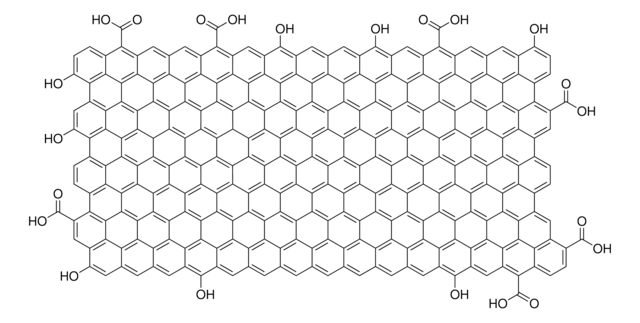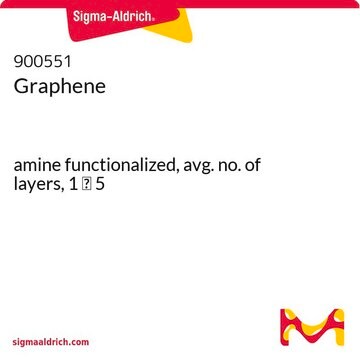This product is not tested for interlayer distance during the quality control process.
796034
Graphene oxide
powder, 15-20 sheets, 4-10% edge-oxidized, avg. no. of layers, 15 ‑ 20
Sinónimos:
graphite oxide
Seleccione un Tamaño
173,00 €
Seleccione un Tamaño
About This Item
173,00 €
Productos recomendados
Nivel de calidad
Formulario
powder
Características
avg. no. of layers 15 ‑ 20
solubilidad
water: dispersible (polar solvents)
densidad aparente
~1.8 g/cm3
cadena SMILES
O=C(O)C1C2=C3C4=C5C6=C7C8=C9C%10=C%11C(C%12=C%13C%10=C%14C8=C%15C6=C%16C4=C%17C2=CC(C(O)=O)C%18=C%17C%19=C%16C%20=C%15C%21=C%14C%22=C%13C(C%23=C%24C%22=C%25C%21=C%26C%20=C%27C%19=C%28C%18=CC(C(O)=O)C%29=C%28C%30=C%27C%31=C%26C%32=C%25C%33=C%24C(C%34=C%35C
InChI
1S/C140H42O20/c141-131(142)26-13-23-15-44-62(140(159)160)45-16-24-14-40-31(132(143)144)5-1-29-41-20-48(135(149)150)56-33-7-3-28-27-2-6-32-55-37(133(145)146)11-9-35-60(138(155)156)42-17-25-18-43-61(139(157)158)36-10-12-38(134(147)148)58-46-21-50(137(153)154)59-47-22-49(136(151)152)57-34-8-4-30-39(19-26)51(23)78-72(44)88-75(45)80-52(24)79(54(29)40)95-71(41)83(56)101-93-69(33)64(28)91-90-63(27)68(32)92-86(66(35)55)73(42)81-53(25)82-74(43)87(67(36)58)96-76(46)85(59)103-97-77(47)84(57)102-94-70(34)65(30)89(78)105-104(88)115-98(80)111(95)116(101)126-122-110(93)107(91)120-119-106(90)108(92)99(81)114-100(82)112(96)118(103)128(124(114)119)123-113(97)117(102)127(130(122)129(120)123)121(109(94)105)125(115)126/h2,5,7-10,12-22,26,38,48-50H,1,3-4,6,11H2,(H,141,142)(H,143,144)(H,145,146)(H,147,148)(H,149,150)(H,151,152)(H,153,154)(H,155,156)(H,157,158)(H,159,160)
Clave InChI
VTWITIAIMADGRM-UHFFFAOYSA-N
¿Está buscando productos similares? Visita Guía de comparación de productos
Categorías relacionadas
Descripción general
- Form: Brown/Black powder
- Bulk Density: ~1.8 g/cm3
- Solubility: Dispersible in water and polar solvents
- Number of layers: 15-20
- Oxidation: 4-10%
Aplicación
- Nanocomposites [1,2]
- Anti-corrosion coatings [3,4]
- Films with barrier properties [5,6]
- Membranes for separation [7,8]
- Conductive inks [9,10]
- Energy storage [11,12]
Código de clase de almacenamiento
11 - Combustible Solids
Clase de riesgo para el agua (WGK)
WGK 3
Punto de inflamabilidad (°F)
Not applicable
Punto de inflamabilidad (°C)
Not applicable
Elija entre una de las versiones más recientes:
Certificados de análisis (COA)
¿No ve la versión correcta?
Si necesita una versión concreta, puede buscar un certificado específico por el número de lote.
¿Ya tiene este producto?
Encuentre la documentación para los productos que ha comprado recientemente en la Biblioteca de documentos.
Los clientes también vieron
Artículos
Since its discovery little more than a decade ago,1 the two-dimensional (2D) allotrope of carbon—graphene—has been the subject of intense multidisciplinary research efforts.
Graphene's unique properties spark interdisciplinary interest; its honeycomb structure offers electrical, optical, and mechanical marvels.
Novel Graphene‑Based Nanostructures Production, Functionalization, and Engineering
Catalytic water splitting produces hydrogen crucial for renewable energy, petroleum refining, and chemical industry applications like methanol production.
-
Can I get information about the interlayer distance of this product?
1 respuesta-
¿Le ha resultado útil?
-
-
How can I determine the shelf life / expiration / retest date of this product?
1 respuesta-
If this product has an expiration or retest date, it will be shown on the Certificate of Analysis (COA, CofA). If there is no retest or expiration date listed on the product's COA, we do not have suitable stability data to determine a shelf life. For these products, the only date on the COA will be the release date; a retest, expiration, or use-by-date will not be displayed.
For all products, we recommend handling per defined conditions as printed in our product literature and website product descriptions. We recommend that products should be routinely inspected by customers to ensure they perform as expected.
For products without retest or expiration dates, our standard warranty of 1 year from the date of shipment is applicable.
For more information, please refer to the Product Dating Information document: https://www.sigmaaldrich.com/deepweb/assets/sigmaaldrich/marketing/global/documents/449/386/product-dating-information-mk.pdf¿Le ha resultado útil?
-
-
How is shipping temperature determined? And how is it related to the product storage temperature?
1 respuesta-
Products may be shipped at a different temperature than the recommended long-term storage temperature. If the product quality is sensitive to short-term exposure to conditions other than the recommended long-term storage, it will be shipped on wet or dry-ice. If the product quality is NOT affected by short-term exposure to conditions other than the recommended long-term storage, it will be shipped at ambient temperature. As shipping routes are configured for minimum transit times, shipping at ambient temperature helps control shipping costs for our customers. For more information, please refer to the Storage and Transport Conditions document: https://www.sigmaaldrich.com/deepweb/assets/sigmaaldrich/marketing/global/documents/316/622/storage-transport-conditions-mk.pdf
¿Le ha resultado útil?
-
-
Could you provide TGA results of these GO? I need a high thermal stability GO like 300-400 stable.
1 respuesta-
Unfortunately, thermogravimetric analysis (TGA) is not performed on this material. The decomposition temperature has not been established. Please see the link below to review an article which suggests that, in general, graphene oxide has a decomposition range by TGA from approximately 125 - 200°C.
https://www.sciencedirect.com/science/article/pii/S2667056923000068#:~:text=Based%20on%20the%20TGA%20and,decomposition%20of%20GO's%20surface%20functionalities.¿Le ha resultado útil?
-
-
How can graphene oxide (P/N: 796034) be homogenized in a PBS solution?
1 respuesta-
The product 796034 is edge functionalized graphene. One method to homogenize it is to use a regular lab ultrasonic bath. The appropriate sonication time depends on the machine power, typically around 15-20 minutes for a 100 Watts ultrasonic bath. If the dispersion is not as expected, the sonication process can be repeated.
Another alternative is to use a homogenizer/cell crasher. A homogenizer with 400-600 Watts is recommended, and it's suggested to set the homogenizer to sonicate for 3 seconds and then pause for 1.5 or 2 seconds, with a total sonication time of 15-20 minutes. Similarly, if the powder is not fully dissolved, the experiment may be repeated.
¿Le ha resultado útil?
-
-
What is the particle size of this product (796034, Graphene oxide)? Is it a nanoparticle?
1 respuesta-
While particle size is not an assigned specification for this product, an estimate is provided below:
d90 - 14.6 μm
d50 - 4.2 μm
d10 - 1.2 μm¿Le ha resultado útil?
-
-
May I get the step-by-step procedure including the materials used to synthesize this product graphene oxide (796034)?
1 respuesta-
This is an MQ100 quality level product, this information is considered proprietary. All of the shareable documentation is on the product page or the documentation linked to on the product page. Synthetic and preparative details are proprietary.
¿Le ha resultado útil?
-
-
Dear Sir/Madam, I am loohking for the thermophysical properties of Graphene Oxided product number 796034. Brand : Aldrich regards Adel
1 respuesta-
Unfortunately the thermophysical properties have not been tested for this product.
¿Le ha resultado útil?
-
-
Do you have data on the diffuse reflectance spectra of eo-GO (796034)?
1 respuesta-
Unfortunately, reflectance spectra is not provided with this product.
¿Le ha resultado útil?
-
Filtros activos
Nuestro equipo de científicos tiene experiencia en todas las áreas de investigación: Ciencias de la vida, Ciencia de los materiales, Síntesis química, Cromatografía, Analítica y muchas otras.
Póngase en contacto con el Servicio técnico





